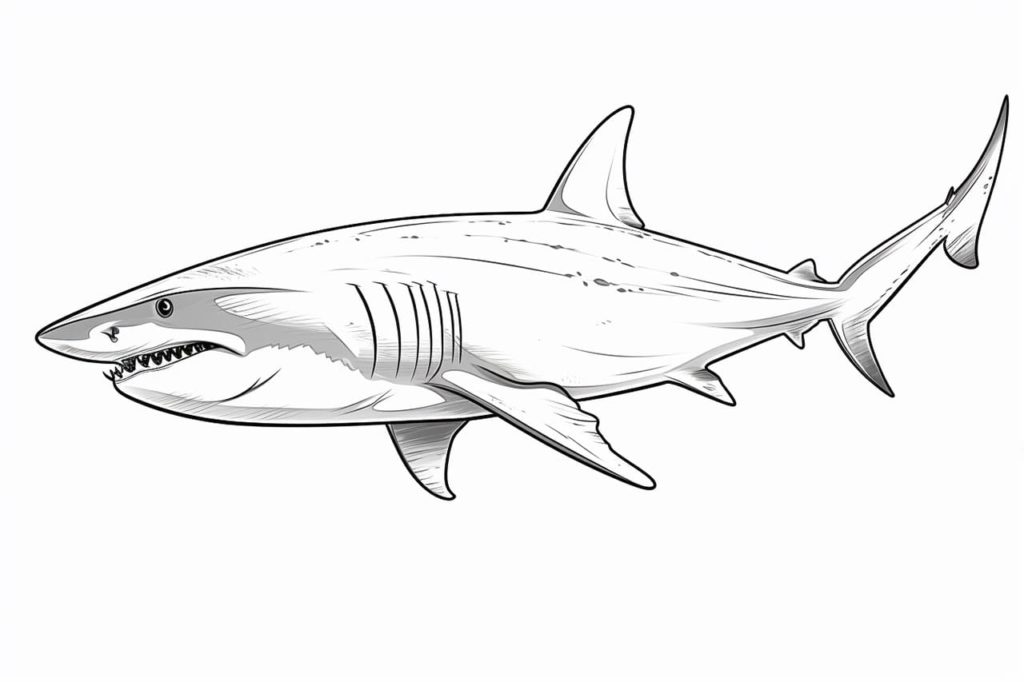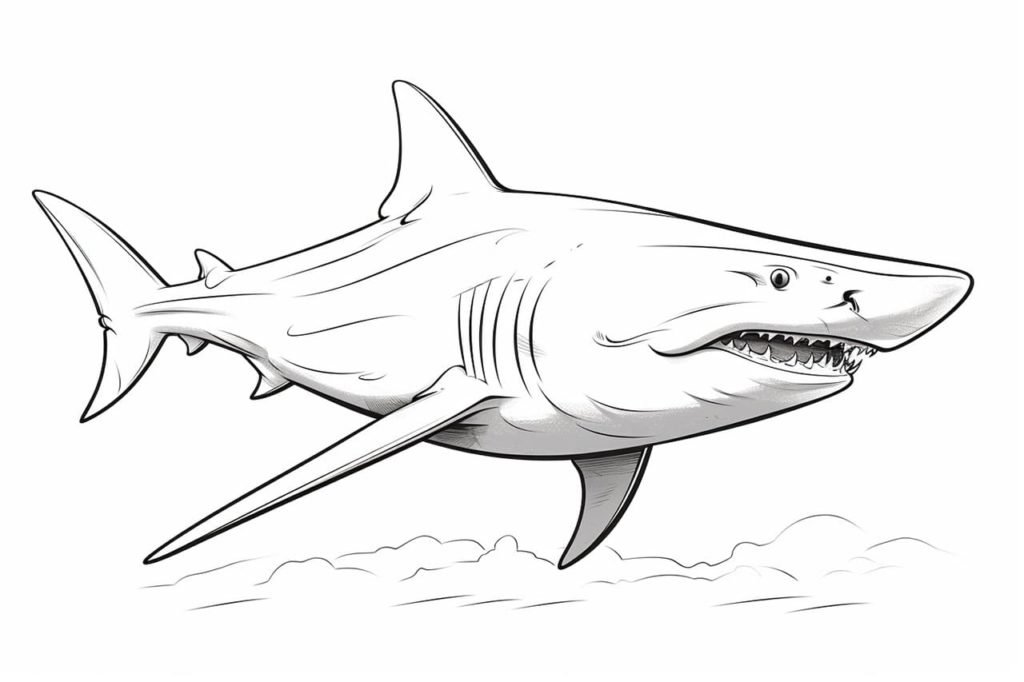
Welcome to this step-by-step guide on how to draw a shark! Sharks are among the ocean’s most awe-inspiring creatures, symbolizing strength, agility, and mystery. Their sleek, powerful bodies and unmistakable fins make them both thrilling and rewarding subjects for artists of all levels.
Whether you’re just beginning your artistic journey or looking to sharpen your skills, this tutorial will guide you through the process of creating a lifelike shark drawing. We’ll break down the shark’s anatomy into easy-to-follow steps, covering its iconic streamlined body, fierce jawline, and powerful tail. Along the way, you’ll learn essential techniques for sketching, shading, and adding dynamic movement to make your shark look like it’s gliding through the ocean depths.
So, grab your drawing materials, set your creative compass toward the open sea, and let’s dive into the exciting world of shark art. By the end of this tutorial, you’ll have a stunning shark drawing that captures the mystery and power of the ocean’s most formidable predator. Let’s make some waves!



Materials Required
To draw a shark, you will need the following materials:
Now that your materials are ready, let’s begin our artistic journey and learn how to draw a shark!
Step by Step Guide on How to Draw a Shark
Step 1: Sketch the Body Shape
Start by drawing a simple oval shape to represent the body of the shark. This shape will act as the foundation for the rest of the drawing.
Step 2: Add the Tail
From the back of the oval, extend two lines diagonally outwards to create the shark’s tail. Make the lines slightly curved to give the tail a more dynamic and realistic look.
Step 3: Draw the Fin
Positioned on the top side of the shark’s body, draw a triangular shape for the dorsal fin. This fin is one of the defining features of a shark and adds to its menacing appearance.
Step 4: Outline the Mouth
Sketch the shark’s mouth by drawing a wide, curved line that starts from the bottom of the oval shape. Create a pointed tip at the end to form the shark’s snout.
Step 5: Add the Eyes and Gills
On the upper part of the shark’s body, draw two small circles for the eyes. Place them towards the front, close to the snout. Just above the mouth, add a series of curved lines to represent the gills.
Step 6: Define the Body Contours
Using the initial oval shape as a guide, draw a more refined outline of the shark’s body. Add curves and angles to give it a more realistic and three-dimensional appearance. Pay attention to the gradual tapering towards the tail and the smooth curves of the shark’s body.
Step 7: Draw the Fins
Extend two more lines from the lower sides of the shark’s body to create the pectoral fins. These fins help the shark steer and stabilize itself while swimming. Add smaller, triangular-shaped fins on the underside of the shark’s body as well.
Step 8: Detail the Features
To make your shark drawing more realistic, add some important details. Draw a line along the shark’s body to represent the lateral line, a sense organ that helps sharks detect movement in the water. Also, add some small lines to define the texture and scales of the shark’s skin.
Step 9: Shade and Texture
Now, let’s bring your shark drawing to life by adding shading and texture. Darken the areas underneath the shark’s body and fins to create depth and dimension. Use short, curved lines to add texture to the shark’s skin, emphasizing its rough and scaly appearance.
Making Waves: Your Shark Drawing Success
Congratulations on completing your shark drawing! You’ve successfully navigated the creative waters and brought this powerful ocean predator to life on paper. By following these step-by-step instructions on how to draw a shark, you’ve learned essential techniques for capturing the sleek form, dynamic movement, and fierce personality of this fearsome predator.
But don’t stop here—there’s a whole ocean of possibilities waiting to be explored. Try experimenting with different shark species, such as the majestic great white, the hammerhead with its unique silhouette, or the gentle giant of the deep, the whale shark. Play with underwater backgrounds, add marine life companions, or create action scenes with sharks in motion.
Remember, every drawing you create helps you grow as an artist. Keep practicing, pushing your creative limits, and letting your imagination swim freely. Who knows? Your next masterpiece might just make an even bigger splash!
Gallery of Shark Drawings



Fun Facts About Sharks
- Sharks have been around for over 400 million years, making them one of the oldest species on Earth.
- There are over 500 different species of sharks, ranging in size from the tiny dwarf lanternshark (around 8 inches long) to the massive whale shark (up to 40 feet long).
- Contrary to popular belief, not all sharks are fierce predators. Some species, like the gentle whale shark and the filter-feeding basking shark, primarily feed on plankton and small fish.
- Sharks have highly developed senses, including keen eyesight, excellent hearing, and a remarkable sense of smell. They can detect a drop of blood in the water from several miles away.
- Some shark species, such as the great white shark, can breach out of the water at high speeds while hunting prey, a behavior known as “spy-hopping.”
- Sharks have rows of replaceable teeth that can number in the thousands over their lifetime. Some species can go through as many as 30,000 teeth in their lifetime.
- Sharks play a crucial role in maintaining the balance of marine ecosystems as apex predators. Their presence helps regulate populations of prey species and keep the ocean healthy.
- Sharks have a unique immune system that makes them highly resistant to diseases, including cancer. Studying their immune system could provide valuable insights for human medicine.
- Despite their ferocious reputation, sharks are actually more at risk from human activities such as overfishing, bycatch, and habitat destruction than we are from them. Conservation efforts are crucial to protect these important ocean predators.
Suggestions for Scenes and Settings for Shark Drawings
Certainly! Here are some specific suggestions for scenes and settings for drawings featuring sharks:
- Underwater Coral Reef: A colorful and vibrant coral reef teeming with various marine life, with a shark gliding gracefully through the crystal clear waters.
- Sunken Ship Wreck: A mysterious and eerie underwater scene with a shark circling around a sunken ship wreck, with beams of light filtering through the water illuminating the scene.
- Tropical Island: A beautiful tropical island with palm trees and turquoise waters, where a shark breaches out of the water in the background.
- Surfing Beach: A scene at a popular surfing beach with crashing waves, surfers riding the waves, and a shark swimming beneath the surface creating a sense of tension.
- Arctic Waters: A snowy and icy setting with icebergs floating in the frigid waters, and a great white shark swimming beneath the icy surface.
- Shark Cage Diving: An adrenaline-filled scene of a shark cage diving expedition, with a shark swimming up close to the cage as divers watch in awe.
- Deep Sea Trench: A dark and mysterious deep-sea trench with bioluminescent creatures illuminating the depths, and a shark lurking in the shadows.
- Urban Setting: A futuristic cityscape with skyscrapers and a shark swimming through flooded streets after a storm, creating a surreal and dramatic scene.
Feel free to use these suggestions as inspiration for your drawings as you learn how to draw a shark!












